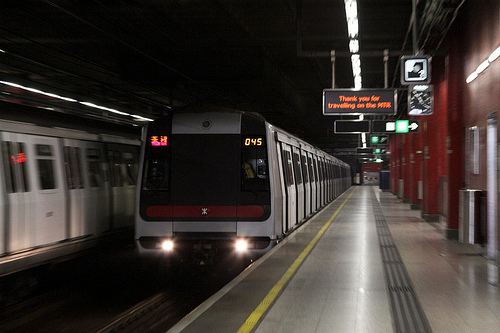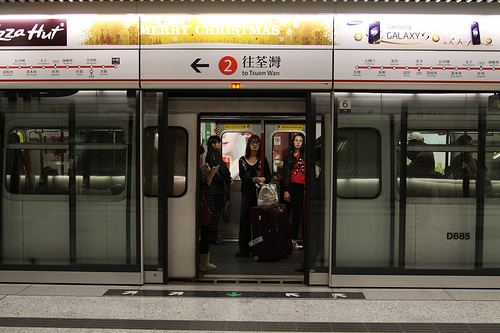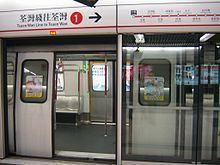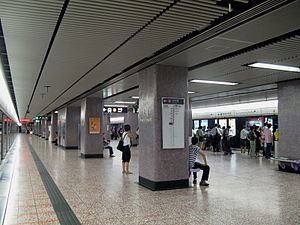Type Rapid transit Depot(s) Tsuen Wan | System MTR Stations 16 | |
 | ||
Locale Districts: Central and Western, Yau Tsim Mong, Sham Shui Po, Kwai Tsing, Tsuen Wan Ridership 1,058,300 daily average
(weekdays, September 2014) Opened 10 May 1982 (1982-05-10) (Tsuen Wan to Lai King section)
17 May 1982 (1982-05-17) (Rest of the line) Terminis Tsuen Wan Station, Central Station | ||
Mtr hd 60 fps metro cammell m stock trains on tsuen wan line kwai fong kwai hing stations
The Tsuen Wan Line is one of the eleven lines of the metro network in Hong Kong's MTR. It is indicated in red on the MTR map.
Contents
- Mtr hd 60 fps metro cammell m stock trains on tsuen wan line kwai fong kwai hing stations
- Hong kong mtr at tsim sha tsui mass transit railway station on the tsuen wan line
- Early construction
- Transfer with Tung Chung Line
- Transfer with former KCR systems
- Chronology
- Route description
- Stations
- References

There are 16 stations on the line. The southern terminus is Central station on Hong Kong Island and the northwestern terminus is Tsuen Wan station in the New Territories. A journey on the entire line takes 30 minutes.

As a cross-harbour route that goes through the heart of Kowloon and densely populated Sham Shui Po and Kwai Chung, the line is very heavily travelled.

Hong kong mtr at tsim sha tsui mass transit railway station on the tsuen wan line
Early construction

The Tsuen Wan Line was the second of the three original lines of the MTR network. The initial plan for this line is somewhat different from the current line, especially in the names and the construction characteristics of the New Territories section.

The original plan envisioned a terminus in a valley further west of the present Tsuen Wan station. That Tsuen Wan West station is different from the current Tsuen Wan West station on the West Rail Line, which is located under land reclaimed at a much later time. The line was supposed to run underground in Tsuen Wan rather than as currently on the ground level.
The final route design allowed for a truncated line. The construction of the branch line to Tsuen Wan was approved in 1975 and commenced soon afterwards. The new section from Tsuen Wan to Lai King and skipping all intermediary stations to Prince Edward opened on 10 May 1982 and joined the section under Nathan Road in Kowloon that had been in service since 1979 as part of the Kwun Tong Line. At opening, Prince Edward was an interchange-only station with no option to enter or exit. It did not become a standard station until the remaining stations on the line in Sham Shui Po District, i.e. Sham Shui Po, Cheung Sha Wan, Lai Chi Kok and Mei Foo, opened a week later.
Several stations differ in names or location from the initial plan. During planning, Kwai Hing was named Kwai Chung, Kwai Fong was Lap Sap Wan (literally "rubbish bay, as the location was close to a now-disused landfill in Gin Drinker's Bay), Lai Wan (currently Mei Foo) was Lai Chi Kok, Lai Chi Kok was Cheung Sha Wan, Cheung Sha Wan was So Uk. These stations were all renamed in English and Chinese before service began.
Upon the opening of the Island Line, Chater, Waterloo, and Argyle, originally named based on the streets crossing or above the stations, Chater Road, Argyle Street, and Waterloo Road respectively, were renamed to Central, Yau Ma Tei, and Mong Kok, resembling the names of the station in Chinese. Lai Wan was renamed to Mei Foo in both English and Chinese.
Mong Kok station was planned to be built a bit further north of its present location and Sham Shui Po a bit further south of its present location before the need to accommodate an intermediary station, Prince Edward.
Transfer with Tung Chung Line
When the Tung Chung Line was constructed, Lai King was selected as an interchange so that passengers did not have to go all the way to Hong Kong Island to change trains. The northbound tracks on the Tsuen Wan Line were moved to run above the southbound tracks at Lai King to support cross-platform interchange with the Tung Chung Line.
The original platform 1 for Tsuen Wan-bound trains was removed and filled, becoming part of the current, wider low-level island platform. This allowed interchange with platform 4 for Hong Kong-bound Tung Chung Line trains, which run on tracks further away from the original platform.
The new platform was opened in 1997, nearly a year before the Tung Chung Line began service. Tracks were also built to the south of Lai King station linking the Tsuen Wan Line and Tung Chung Line; this is the only point where the Tung Chung Line connects with the other urban lines.
Transfer with former KCR systems
To cope with extensions and new lines, Mei Foo and Tsim Sha Tsui stations had new subsurface walkways added to connect to West Rail Line's Mei Foo and East Tsim Sha Tsui Stations. The interchange facilities at Mei Foo opened in 2003 when the West Rail was opened. The interchange located at Tsim Sha Tsui entered service in 2004, along with the completion of the East Rail Line's (formerly KCR East Rail) extension to East Tsim Sha Tsui.
Chronology
Route description
The Tsuen Wan Line runs north-south. It is mostly underground, beginning at Central and crosses Victoria Harbour after Admiralty to Tsim Sha Tsui. Then, the line first runs underneath Nathan Road (Tsim Sha Tsui to Prince Edward), then Cheung Sha Wan Road (Sham Shui Po to Mei Foo), before emerging from the hills at Lai King.
The line is elevated between Lai King and Kwai Hing. Between Kwai Fong and Kwai Hing, the tracks are covered to minimise disturbance to residents nearby. After Kwai Hing, the line re-enters the tunnel to Tai Wo Hau before finally re-emerging at ground level at Tsuen Wan.
Some of the underground stations on the line are significantly deeper than the others. Tsim Sha Tsui and Admiralty stations are deeper because they precede harbour crossings. Admiralty and Central are deeper they provide cross-platform interchange with the deep-level Island Line.
Stations
The following is a list of the stations on the Tsuen Wan Line.
